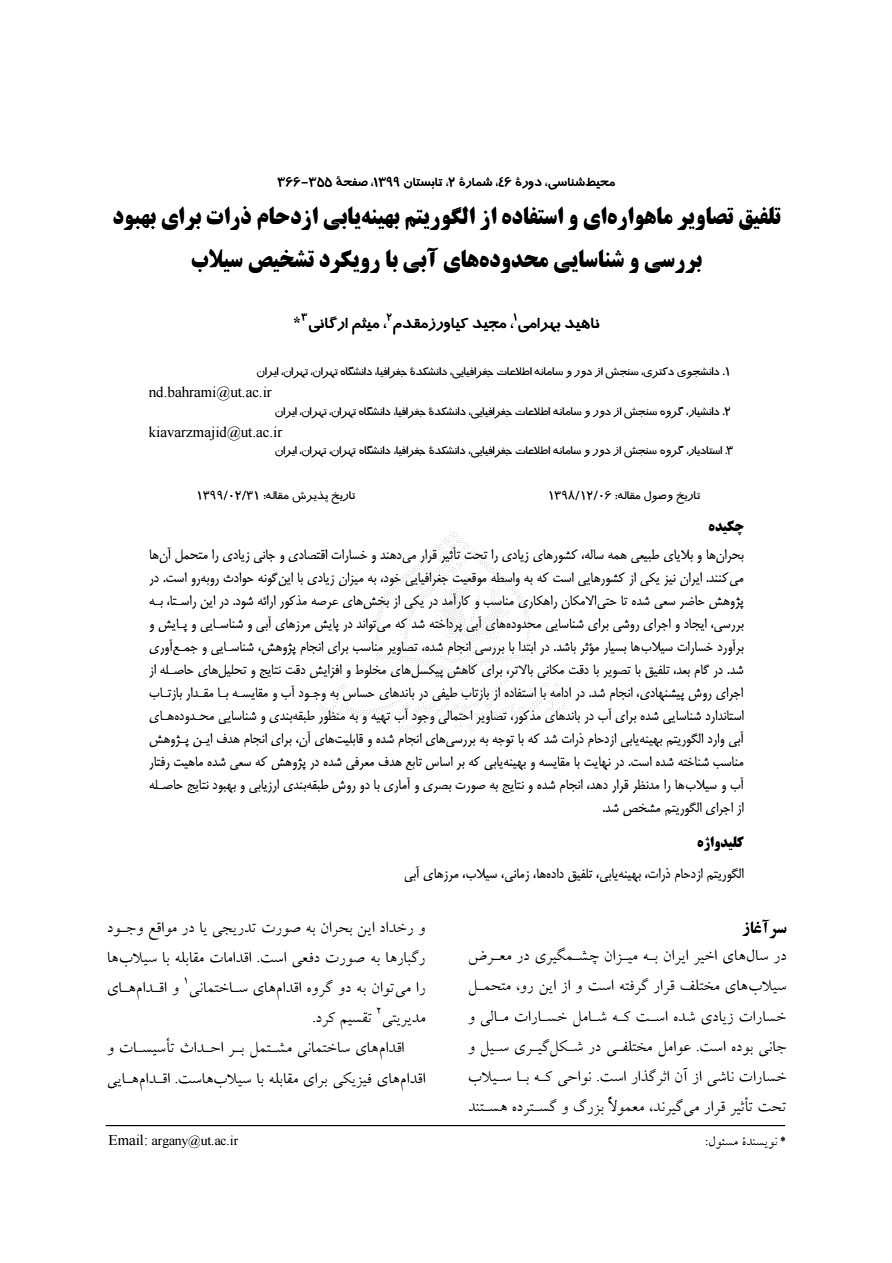Abstract:
بحرانها و بالای طبیعی همه ساله، کشورهای زیادی را تحت تاثیر قرار میهند و خسارات اقتصادی و جانی زیادی را متحمل آنها میکنند. در این راستا، به اجرای روشی جهت شناسایی محدودههای آبی در پایش مرزهای آبی و شناسایی و برآورد خسارات سیلابها بسیار مؤثر باشد، پرداخته شد. در ابتدا با بررسی انجام شده، تصاویر مناسب جهت انجام پژوهش شناسایی و جمعآوری شد. در گام بعد، تلفیق با تصویر با دقت بالاتر، جهت کاهش پیکسلهای مخلوط و افزایش دقت نتایج و تحلیلهای حاصله از اجرای روش پیشنهادی، انجام شد. در ادامه با استفاده از بازتاب طیفی در باندهای حساس به وجود آب و مقایسه با مقدار بازتاب استاندارد شناسایی شده شده برای آب در باندهای مذکور، تصاویر احتمالی وجود آب تهیه و وارد الگوریتم بهینهیابی ازدحام ذرات که با توجه به بررسیهای انجام شده و قابلیتهای آن، برای انجام هدف این پژوهش مناسب شناخته شد، گردید. در نهایت با مقایسه و بهینهیابی که بر اساس تابع هدف معرفی شده در پژوهش که سعی شده تا ماهیت رفتار آب و سیلابها را مدنظر قرار دهد، انجام شده و نتایج به صورت بصری و آماری با دو روش طبقهبندی مورد ارزیابی قرار گرفت و بهبود نتایج حاصله از اجرای الگوریتم مشخص شد.
Introduction Iran is one of the countries that, due to its geographical location, is facing a lot of natural disasters that affect many countries and causes a lot of economic and human losses every year. In recent years, Iran has significantly exposed to floods. Because human activity has concentrated in flood-prone areas, which are often the right places to live and economic activity, there is a probability of being a lot of damage. It has caused financial and human losses. Reports of relief and crisis response from the United Nations inferred that floods should be considered one of the most severe natural disasters. The goal of the prevention of floods damage is to improve the quality of life by reducing human and public losses, both economic and environmental. Flood management actions can have divided into two groups: structural actions and management actions. Structural actions include the physical activities [1] for buildings and facilities to deal with floods, such as actions improving the route of the river, construction of reservoir dams, and longitudinal coastal embankments. These actions are the hardest part of dealing with floods. Management actions include a variety of precautionary actions to reduce flood damage, including land-use control and warning systems of the flood. Such actions constitute the Software aspect of confrontation in floods. These actions should have taken in three areas: flood prevention, response and reconstruction, and improvement of the damaged regions. As mentioned earlier, one of the management actions is flood warning systems to estimate the damages. In this research, have been tried a cost-effective solution to identify and evaluate and damage estimates floods created and provided to using in Flood warning systems. Methodology and Implication Part of the Caspian Sea has selected as a suitable study area due to the presence of pure water bodies. Images of the Landsat 8 satellite, the OLI sensor, have been used as the data source to prevent the impact of various sensors. All images selected are cloudless to reduce cloud impact. To minimize time processing, a clipping of images has considered. Some of the images were to validating this purpose method. The resolution of Landsat images (30 m) is vast for identifying small pieces with mixed pixels. For the increasing spatial resolution of images, the IHS image fusion algorithm has used with the panchromatic image. Due to the spectral behavior of water in different bands, NIR, SWIR, and Green bands were recognized and used. March 2019 has considered due to the floods around the Caspian Sea. The study area was selected part of the Caspian Sea border, around Kiashahr near Lahijan. In the first step, to improve the accuracy of the final results, the three selective bands were combined with a panchromatic band that has twice resolution (15 m) of the above bands. In the next step, small areas in the deeper part of the sea that do not have cloud cover were used as the standard reflectance of water and to calculate the degree of classification error. The vector angle values of the band and the water reflectance standard value its (such as SAM method) and the distance their values were used to create the map. Probability water in each pixel, its reflectance proximity to the standard reflectance of water in the same band, will be between zero and one. After creating a probabilistic map of the existence of water, this map enters the optimization algorithm as a relatively simple classification. According to the goal of implementing an optimization algorithm that is detecting and extracting the water range from images, creating a map of the probability of water can be an excellent initial solution for better implementation of the algorithm. In the optimization algorithm, before the implementation of such algorithms, the objective function should be defined, and it used to the optimizing problem. When its value is more valuable in this problem, that is Larger value. In this research, a means of maximized value is more probability of water. Function and particle swarm algorithm coefficients have determined from the beginning of the algorithm implementation. c1, c2, φ1, φ2, and w, in the PSO algorithm structure, and k1, k2, and k3 in the objective function are coefficients whose values are determined. In the following, Relationship 1 is The function of calculating the probability map of water, Relationship 2 is the objective function [2], Relationships 3, and 4 are a function of the particle swarm algorithm [4,5]. At each stage of implementation, the status of pixels was compared with the best solution of the objective function, if it is better than the best solution up to replace. In addition to each pixel, It will have saved the objective function calculated for the whole range. If the response was better than the optimal state of the global solution, it replaced. In this way, the answers have compared with the most optimal solution Due to defining conditions for the algorithm. Finally, after 500 repetitions, the algorithm ends. Figure 1 is a visual comparison of the proposed method and methods of SVM and k-means in the study area. By studying and checking the optimization algorithms, the particle swarm algorithm as a collective intelligence algorithm that takes effects of the neighborhood [5], According to the water behavior and The process of creating floods, will be advantageous. This algorithm was selected using an objective function that would cover the essential issues and considering the water probability in the points and the impact of the neighbors. To improving the usability research optimization algorithm, a relatively right initial solution was created by the probabilistic maps of the presence of water in the pixels and using spectral behavior of water and spectral reflection in the used bands. Conclusion Finally, the performance of the proposed algorithm was visually and statistically compared with several other classification methods such as SVM and k-means. The Overall Accuracy and Kappa Coefficient values calculated and compared for statistical comparison. The OA value of 98.93% for the proposed algorithm, 98.39% for SVM and 96.73% for k-means, and KC 95.6%, 91.2% and 67.8% to the proposed research algorithm, SVM and k-means. As a result, The proposed algorithm found to be useful and appropriate in this problem. Figure 2 is a statistical comparison chart of the proposed method and methods of SVM and k-means. Future Work For future research, other techniques can be used on fusing images and compared with the used method. On the other, using radar images causes increasing accuracy and eliminating cloud effects. Using Modis satellite imagery due to its wide range of spectrum can better distinguish the components of pixels. The using meteorological satellite images to improve the time series of studies, and the quickly monitoring and predicting floods can have a good effect. And using different methods of optimization and comparison with the proposed method in this research to improve the identification and monitoring and pathology of crises such as floods, can be beneficial. Using the time series of images will also be very appropriate and efficient.

(پژوهیار,
,
,
)

